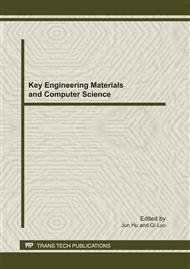p.14
p.20
p.26
p.33
p.38
p.45
p.52
p.58
p.64
Atomistic Simulations of Heat Transport in Carbon Nanotubes Effected by Temperature and Stretch Strain
Abstract:
Carbon nanotubes (CNTs) is a well thermal transport nano materials, however, the thermal conductivity of CNTs has not been well established, only a few groups had reported experimental data and the existed simulation results ranged widely. Specially, the conclusions in low temperature section and dynamic structures were not very clearly. In this paper, the methods based on phonon scattering theory were applied to explore the thermal transport properties CNTs. The investigation was carried out under the conditions of temperature and axial strain. In the consideration of quantum effect, the thermal conductivity increased linearly with the growth of temperature in low-temperature section, and began to decrease gradually when the temperature exceeded a definite value. If an axial strain was concerned, there was an increasing trend of thermal conductivity as the stretch strain increases. However, after the strain exceeded a particular value the thermal conductivity decreased significantly. In addition, the high frequency phonon peak in PDOS was found to be an important parameter in describing thermal transport properties of dynamic structures.
Info:
Periodical:
Pages:
38-44
Citation:
Online since:
August 2011
Authors:
Price:
Сopyright:
© 2011 Trans Tech Publications Ltd. All Rights Reserved
Share:
Citation:


